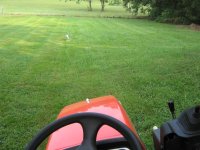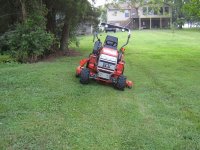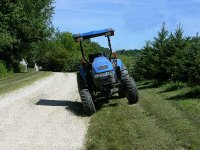I used to be a helicopter instructor pilot, and two things I learned doing that dangerous activity also apply to operating a tractor on a slope.
1) A new "pilot" (tractor operator) may be very cautious at first - sometimes to the point of underusing the capabilities of the machine. However, after a while, they often become complacent (or even overconfident), to the point of exceeding the limitations of the machine. Enventually, given enough experience, most pilots gain the ability to almost become one with the machine, without ever forgetting that it will bite you if you don't respect it. When you reach that point, your "pucker factor" becomes a pretty good judge. But almost every "old timer" can tell you some story about the time their overconfidence either caused them to have an accident, or how they narrowly avoided such an event. (I used to refer to those incidents as "pucker factor recalibration"...) You can learn a lot by watching someone who is skilled operate your tractor. Just don't make the mistake of thinking you can do everything the same way they do... They've developed that "control touch" through experience...
2) There is a thing called "dynamic rollover" that affects all machinery operating on slopes. I'm going to try to give a quick explanation.
Visualize a tall, skinny triangle sitting on the slope of a hill, with a weight on the top. That's an exaggerated "picture" of your tractor, with the spot where the wheels tough the ground being the bottom corners of the triangle, and the "center of mass" of the tractor (probably just about the operator's seat height) is the weight at the top of the triangle.
So, what does "maximum slope" capability mean? If you tilt the triangle (place it on a slope), you reach a point where a vertical line drawn straight down from the center of mass (called the CG line - for Center of Gravity) falls outside the base of the triangle. At that point, the triangle will tip over. Thus, the "maximum slope" capability is the maximum angle where the CG line still remains inside the triangle's legs (tractor's wheels).
On a "normal operation" slope, the CG line falls somewhere between the tractor's wheels. On an "excessive" slope, the CG line falls outside the wheels, and the tractor will roll over - operator skills have nothing to do with this. It's just the law of gravity.
Going back to our skinny triangle with the weight on top for a minute: Imagine that you rock the triangle from side to side (as if driving over uneven ground). It's not hard to visualize that at some point, the weight up on top develops enough momentum as it moves to the side that it develops enough force to cause the entire triangle to tip over. This is called "dynamic rollover", and it can cause a tractor to roll over on a slope that is less than the "maximum slope" angle.
Imagine you are operating on a slight slope (downhill to your right) that is well within the maximum slope ratings for your equipment. Just for the sake of argument, let's assume you are operating with a heavy load raised high in the FEL (exaggerated conditions). As you drive along, your left front tire rolls into a rut, causing the FEL to swing slightly to the left. You are well within the slope limits, and the swinging force of the FEL is countered by the tractor's weight, the low center of gravity, the wide wheel stance, etc. Just as you start to catch your breath, your left wheel come up out of the rut, and your right wheel drops down into that same rut, but it's a bit deeper here. The loaded FEL begins to swing back to the right, but faster than it did to the left because of the abruptness of the change from left-side-low to right-side-low. Technically, even with this additional "slope" added to the natural slope of the hill, you're still within the "maximum slope" operation area as stated by your manufacturer. This time, however, the side-to-side force generated by the "heavy and high" load in the FEL as it swings back to the right builds momentum to a point where it overwhelms the tractor's design, and it rolls over onto its right side.
In my example, all the conditions were right for a dynamic rollover, even on nearly level ground. But dynamic rollover can occur at much lower CGs (heavy and "low" bucket) if the slope is steeper (say within a few degrees of your maximum), or if the "roll rate" is faster, or if the operator turns "into the slope" (to the left in our hypothetical situation).
There are some factors that can amplify the "rate of rotation" (or the abruptness of the "tilting force") over which you have little or no control. Things such as ruts, ridges, or berms (especially if nearly parallel or diagonal to your line of movement) are beyond your control, but you can anticipate them and work more slowly and carefully.
There are other things that are solely within the operator's control, such as speed of movement, where to carry a load (low vs. high FEL bucket, etc.), steering inputs (such as sudden uphill turns), and the decision to drive cross-slope versus up/down-slope.
Just as in learning to fly helicopters, the secret is to start off slowly, be more cautious when operating on uneven terrain, and always operate well within the safety margins of both the equipment and the operator. For most of us, the operator's limitations far exceed those of the equipment.
As one of my old instructors used to say:
"Better to be on the ground, - wishing you were in the air,
than to be in the air - wishing you were on the ground!"




